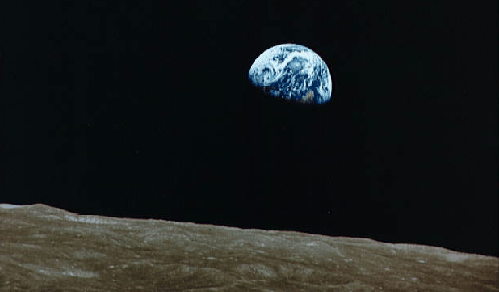That Chunk of Earth Called Moon
Skip the B.S.
by Skip Eisiminger
“A corpse on the road of night . . . .”—Richard Burton
“A circumambulating aphrodisiac . . . .”—Christopher Fry
CLEMSON South Carolina—(Weekly Hubris)—4/25/11—My paternal grandfather’s speech was stippled with lunar phrases like “planting moon,” “strawberry moon,” “harvest moon,” and “snow moon.” Though he had worked 20 years for a small Illinois railroad before I met him, his vocabulary was still alive with the language of his grain-elevator-manager father, who raised almost everything the family ate, but who died two years before I was born.
It’s a pity so many of these seasonal lunar references are slipping from our grasp, because they have a way of grounding us in the rhythms of nature.
My wife, Ingrid, grew up in a farm village in north-central Germany, and naturally acquired those rhythms listening to the horse-drawn wagons clatter by her home on the way to the rye and sugar beet fields that still embrace Wolsdorf. As children, she and her brother would sweep up “horse apples” for their parents’ and grandparents’ backyard garden and orchard. They had to be observant and quick because they were not alone in collecting organic gold.
Though Ingrid scoffs at any connection between full moons and birth rates, she reckons, as folk are wont to do, that there is a correlation between full moons and colder weather. For 40 years now, I have tried to disabuse her of this quaint notion, but it seems that every time we notice a full moon, it is five or ten degrees cooler than the night before. I’ll grant her this much: the world certainly looks colder frosted in moonlight.
I was pleased to learn some years ago that in England the 12th of December is celebrated by “drawing down the moon.” As it happens, this old Druid was born on December 12th. At midnight, my Wiccan friends tell me, the moon’s power is invoked in drinking, dancing, and frolicking. If Diana or Astarte is suitably impressed, the powers to fly and withhold daylight are granted to the chief priestess. I can’t say that I’ve ever been much of a drinker or a dancer, but something about frolicking under the moon with nubile women resonates with me. But then, anything with the power to lift the ocean and cause the earth to swell is a force to be reckoned with. In some places, the moon winches up the sea 50 feet or more and buckles the Earth’s crust 16 inches twice a day.
I recall reading in the newspaper a few years ago that we were scheduled for a “blue moon,” so I waited until dark before entering my back-yard “observatory.” Just as advertised, the moon was full for the second time in June. Now, I’ve seen a “blue moon,” and it was orange, though after some volcanic explosions, it really is blue.
Unlike Halley’s forty-watt fly-by in 1986, the Technicolor moon I witnessed was a sight to glop at. I recall thinking that while Jupiter and Saturn have 60 or more moons each, Mercury and Venus don’t have any. (The solar system’s moon census in 2011 stands at 174, thanks to the keen eyes of the Hubble telescope, which orbits some 300 miles above.)
Our paucity of moons (and moons in general) have been much on my mind of late.
Bemused by the South Carolina state flag, I found myself wondering what the white crescent moon on a navy blue background represented. To my great surprise, I discovered in the state constitution that most flags have it wrong: instead of pointing upward at a 45-degree angle, the points of the increscent should squarely face the flagpole from which it hangs. I wrote this all up with pictures and documentation, published my findings in the South Carolina Review, and waited for the thunder.
Five years later, I’m still waiting to hear from Columbia.
Incidentally, the only flag I’ve seen that positions the crescent correctly was made in Taiwan.

Like heraldry, accurate knowledge of the moon is in short supply. I know this because for years when I was teaching full-time I used the “Moon Survival Exercise” as the basis for an analysis paper in some of my sublunary writing classes (where I once learned that we only walk in our sleep during a full moon).
In the exercise I used, designed for NASA by Dr. Jay Hall of the US Naval College, a hypothetical space ship crashes on the moon, and the survivors are faced with transporting themselves to the mother ship, which sits helpless a hundred miles away.
Fifteen items, ranging from a hundred-pound oxygen tank to a first-aid kit, have survived the crash, and the subjects are instructed to rank these in the order of their importance. Why the ranking is necessary is not explained, nor is the fact that on all six Apollo missions, the mother ship remained in a lunar orbit. Furthermore, the subjects are never told how many are in the crew nor whether anyone has been injured.
A few students recognized these failures, but most were clueless on Luna. The students, however, were not entirely to blame because, among other things, Hall assumes the survivors can remove their helmets to eat and drink in the vacuum of space when, of course, they cannot. (Hall’s ignorance should not be surprising when you consider that one in five Americans still thinks the Sun orbits the Earth, just as untold numbers think there’s a connection between the moon and a woman’s menstrual cycle. The link exists, but it’s purely etymological.)

NASA’s critics never tire of saying that the government spent $24 billion for some Tang, Teflon, and 800 pounds of moon rock. However, the photograph of “”the blue planet” sinking over the moon’s horizon, set against the black velvet of space, was worth every dime to me.
That picture, now a poster taped to thousands of walls, has led billions of hopelessly earth-bound humans to shed their top-of-the-food-chain illusions, as the image underscores their vulnerability.
In 1835, when Richard Locke jokingly claimed that Sir William Herschel had seen winged humanoids on the moon, a group of pious Christian women immediately started raising money to send missionaries to convert them.
In a sense, though, the true missionary came to Earth in the form of NASA’s memorable photograph. Anyone who has ever tried to impress upon the young the importance of saving Earth’s fragile environment need only project that dot of blue in a darkened classroom. Everything we hold dear is inside that dot which, from the moon, may be eclipsed by a thumbnail held at arm’s length.